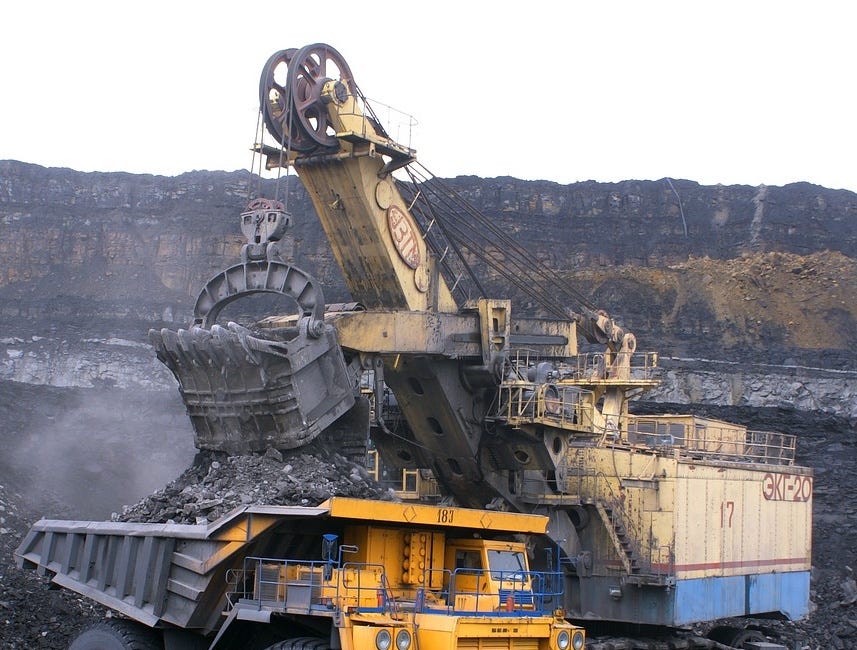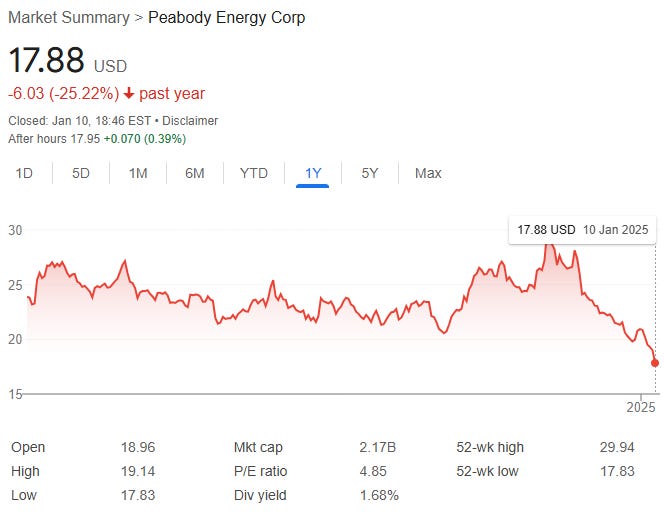Update on Met Coal Markets: A Buying Opportunity
Balancing Risk and Reward: A Long-Term Perspective on Coal
The coal market has been highly volatile. After I published my thesis, coal stocks surged when China introduced its economic stimulus program, though I warned that market expectations were overly optimistic and suggested trimming some positions. The program ultimately proved weaker than anticipated, causing a market correction.
When President Trump won the election, coal stocks rallied again, but they later experienced a large sell-off as metallurgical and thermal coal prices stagnated and fell below the 200-dollar mark for premium low-vol Australian metallurgical coal. This decline can be attributed to a slower-than-expected economic revival in China, along with softer demand growth.
Looking ahead, coal price movements will depend on global economic conditions, policy shifts, and underlying demand drivers for both metallurgical and thermal coal. For a deeper analysis of these dynamics, please refer to my thesis on the metallurgical coal sector, which lays out the factors influencing recent price trends and future prospects.
Let me wrap up everything for you in case you need a quick reminder, while many developed countries have largely phased out coal, developing nations continue to rely on it for power and infrastructure, with metallurgical coal serving as a higher-quality variety crucial for steel production. India and China, in particular, are expected to see significant growth in housing and industrial development, driving robust steel demand for at least the next decade. In the short term, however, the coal market is under pressure because China’s economic challenges have curbed its coal consumption, led to a surge in steel exports, and pushed coal inventories to record highs, all of which have driven prices down. Although global coal demand is set to rise gradually over the next three years, immediate headwinds persist. Nevertheless, long-term growth in coal demand should remain resilient, powered by ongoing development in China and India, with Africa emerging as another potential contributor.
Demand for coal has been softer than expected, and the anticipated “bazooka” of Chinese economic stimulus has disappointed investors. On top of that, CEIX and Consol are merging and have suspended share buybacks until the deal closes, AMR has paused its buyback program, BTU just made a sizable acquisition, and HCC is waiting for the Blue Creek mine to become fully operational. None of these moves align with what the market typically rewards—namely buybacks and dividends.
Despite this, I see a strong buying opportunity. India’s demand will continue to rise, and China’s demand is likely to rebound once its economy recovers in the coming years. In the United States, the potential for increased coal consumption under the Trump administration could further support prices. With many smaller miners struggling at current price levels and large-scale investments in new coal projects on hold, future coal supply will likely decrease. Although India aims to boost its production, global supply is still expected to decline. This mix of resilient demand and tightening supply creates an attractive setup for investing in coal at a time when most market participants are pessimistic about its outlook.
Metallurgical coal demand is projected to dip slightly over the next three years, primarily due to ongoing difficulties in China’s real estate sector.
My thesis is straightforward: demand and supply in the met coal market should stay balanced, with potential upside catalysts such as a Chinese economic recovery or increased trade tensions with Russia. Most risks appear to be priced in, and the market is currently focused on near-term uncertainties—precisely when opportunistic investors should consider buying.
I plan to capitalize on this through a few well-known names: AMR, HCC, and BTU. I’m also on the lookout for an undercovered company with a more attractive risk-reward profile, but for now these three are my favorites.
AMR is known for robust buybacks, strong cash flows, and a clear commitment to shareholder returns. Although it has paused its buyback program to rebuild cash reserves—an understandable move if coal prices stay low—it remains well-positioned. If prices pick up and management restarts buybacks, it could provide a strong boost for the stock.
HCC’s story remains centered on waiting for its new mine to come fully online. Investing in HCC is effectively a bet on mid- to long-term coal prices, so its performance may be less affected by the day-to-day volatility that could persist into 2025. For further details on HCC, you can refer to my previous thesis.
BTU is a more speculative option, given that management went against market expectations by acquiring additional coal assets. Despite initial skepticism, this move positions Peabody to become the world’s leading seaborne coal producer at a price of $3.8 billion. The acquisition, completed at an EV-to-EBITDA ratio of around 3.1, appears attractive and offers potential synergies, although Peabody’s high per-ton costs make it effectively a leveraged call option on met coal prices. In other words, if prices rise, Peabody could benefit substantially from these depressed levels.
Overall, I see the met coal industry as an appealing long-term opportunity for investors who focus on underlying fundamentals and data rather than short-term market sentiment.
Disclaimer:
The information provided in this article is for informational purposes only and should not be considered financial advice. The content does not constitute a recommendation to buy, sell, or hold any security or investment. Always do your own research and consult with a professional financial advisor before making any investment decisions. Investing in stocks involves risk, including the potential loss of principal. Past performance is not indicative of future results.












Hi Hugo, thanks for the write up. Even as someone who's been following the coal space for a few years now, I've learnt some new things from your write up. What are your thoughts on thermal? It seems the demand and supply gap is even more favorable for thermal compared to met! What's your view on the best way to play thermal? Have you looked into the aussie names (Yancoal, New Hope)?
Growth in development of housing in China has been and gone. The population is now in decline, with <1.2 births per woman, and entire cities built to handle the then-growing population now sit empty. What has been a major growth tailwind to coal consumption in the past is now going becoming a major headwind.
I don't have any broader opinion on the valuation of AMR - just thought you should be aware.